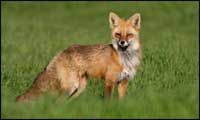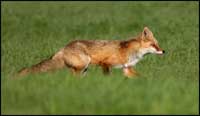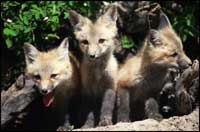Red Foxes
Had it not been for some early pioneers and their packs of well-trained hunting hounds, the red fox might never have found its way to Texas. Not a native species, it was imported to provide sport and training for fox-hounds. The red fox's strong, streamlined body is perfect for running, and it seems to enjoy a good chase. It is capable of sudden bursts of speed that have been clocked up to forty-five miles per hour, and it can run in front of a pack of baying foxhounds all night.
The entire red fox population of Central Texas probably descended from forty foxes released between 1890 and 1895 near Waco. Offspring from these, plus an additional sixty imports, soon spread into the surrounding counties. Releases in other parts of the state further increased the red fox's range. Now it can be found in the eastern, north-central, and Trans-Pecos areas of the state. Highest populations occur in north-central Texas.

Its strong, streamlined body is perfect for running, and the red fox is capable of sudden bursts of speed.
Early pioneers were not the only ones who recognized the red fox's value for dog-training purposes. According to a short item published in a 1959 issue of the Texas Game and Fish magazine, thirty-eight red foxes were trapped in Central Texas that year and shipped to East Texas to be housed in artificial dens and trained to run hounds. Cages were placed at the entrances of these artificial dens until the foxes were established in their new homes. Then the cages were removed so the foxes could roam free and get to know their surroundings. The next step in the training program was to introduce the hounds. When the fox left its den at night, a lantern was placed at the entrance to keep the fox from re-entering. The dogs were released, and the fox was forced to make two or three rounds of the area with the dogs in pursuit. Then the lantern was removed, and the fox was allowed to enter its den. After a few training sessions, the foxes learned what was expected of them, and the lanterns no longer were needed to keep them out of their dens. They even seemed to enjoy giving the hounds the run-around. Offspring of these foxes may be giving East Texas hounds the run-around today, but the foxes are on their own now.
The red fox is a member of the dog family (canid), but it still displays quite a few catlike (feline) characteristics. The young hiss and spit like kittens, and adults can make short mewing cries and high-pitched screams. The fox also can assume the cat's threat posture, standing with back arched and fur erect. This display may be followed with a broad-side, stiff-legged charge. Canid eyes normally have round pupils, but the red fox has elliptical (vertical-slit) pupils like those of a cat. Its sensitive face whiskers also are proportionately longer than those of other canids, and its feet are more catlike. Its flexible paws have small toe and foot pads as well as partially retractable front claws. The rest of its foot is soft and covered with hair that may make it more touch-sensitive during the fox's catlike stalk. Its daggerlike canine teeth, short muzzle, and strong jaw muscles allow it to make a killing bite on its prey.
Canids and felids usually use distinctly different hunting strategies, but according to J. David Henry, a biologist who has spent six years studying red foxes in Canada, this fox hunts the same kind of prey species as cats, and its hunting habits are more feline than canine. Hunting methods of dogs are based not on stealth, but on detection, and scent plays an important role. Dogs often hunt in packs, approaching their prey openly and relying on endurance to run it down. If they get close enough, they repeatedly bite the prey's vulnerable rump and hind legs. Weakened by the wounds or chase, the prey is pulled down and killed by the pack. Cats are solitary hunters, relying on a surprise attack, combined with a burst of speed, to take their prey. The red fox also is a solitary hunter, perhaps because its prey usually is only big enough to feed one. It is a skilled predator and adapts its method of hunting to the type of prey it is stalking at the time.

The red fox displays quite a few of the breed's feline characteristics: elliptical, rather than round, eye pupils; sensitive face whiskers proportionately longer than canines'; and catlike feet with partially retractable front claws.
Insects offer little challenge to the fox's hunting abilities. If one is spotted on the ground, the fox merely walks over, picks the insect up by mouth, and eats it. If the insect hops or flies, the fox searches for it by nosing into the vegetation or tapping around with a forefoot (catlike) to cause the insect to move. The fox then tries to grab it by mouth. Birds and squirrels are hunted by a stop-start method. Anyone who has ever watched a cat stalk a bird will recognize this hunting technique. The fox synchronizes its movements with those of the prey to minimize visual danger clues and noise warnings. Any movement noises made by the advancing fox coincide with those of the prey. When the prey looks away or begins to eat, the fox advances in a crouched position with its belly almost touching the ground. This advance may be made at a slow stalking pace, a trot, or a gallop. The fox never takes its eyes off the prey. When the prey looks up to check its surroundings, the fox freezes and remains motionless, sometimes in mid-stride, until the prey resumes feeding. At the end of the stalk, the fox makes a horizontal jump and attempts to catch the bird or squirrel in its mouth.
Rabbits are hunted by a method that combines both feline and canine techniques. When the prey is sighted, the fox crouches and begins its cat-like stalk. If the rabbit senses danger and runs, the fox immediately switches to the canine method of hunting. It pursues the rabbit with a bounding gallop and attempts to bite the legs or rump. If the fox manages to get a bite hold, it pulls the rabbit off its feet and both animals may collapse on the ground. When the fox regains its footing, it stands on the prey to pin it to the ground and then bites its neck and/or head to kill it.
When the red fox is hunting small animals that rely on sound to detect danger, it is extremely careful to minimize movement noise. The approaching stalk is made slowly, and the fox tests each step for a possible sound warning. The forefoot is put down lightly and may even be moved a couple of times before the fox is satisfied that when it shifts its weight to that foot no noise will result. The hind foot is then advanced to the exact spot where the forefoot was previously located. Since visual warnings are not as critical for this type of prey, the fox may lift its head and cock it from side to side to locate the prey's exact location. When the fox has advanced within striking distance, it crouches low and then lunges through the air in an arc, trying to pin the prey to the ground as it lands. This lunge usually varies from two to six feet, but the fox can cover as much as fifteen feet from a standing start. Hunting on the downhill side of a trail increases the lunge, allowing the fox to stay airborne up to twenty-five feet.
Red foxes are opportunistic feeders. This means they will eat whatever is available. Eggs, carrion, berries, and garbage are eaten as readily as live prey.

Young red fox remain inside the den for at least a month. they then venture outside to wrestle and fight playfully with littermates over food.
The breeding season for the red fox in Texas begins early in the year, and the shrill squalls of the female (vixen) bring answering barks from any nearby males. If more than one male responds to her call, they compete for her attention. The winner of the resulting fight gets her. The pair then must find a suitable den and get it ready for the young that will be born about fifty-one days after mating takes place. Usually the den is an underground burrow, a crevice in a rocky outcrop, or a cavity under some boulders. Occasionally the pair will take over the burrow of some other animal, such as a badger, and remodel it to suit themselves.
Litters may vary from four to fifteen, but the most common size is five or six. The pups, which look like kittens, are dark brown or black and have a white tip on their tails. Their eyes open in nine days, but for at least a month they remain inside the den, where the female gives them constant attention. Since she must remain with them for the first few weeks, the male brings food to her and stands guard over the den. If danger approaches, he warns the family with a bark and then tries to lure the intruder away. When the pups grow older they are fed at the mouth of the den, venturing outside to wrestle and fight with their littermates over the food. But whether they are fighting over food or just rolling and tumbling together in play, they are amazingly quiet. The only sound may be a small squeak of protest when one of them gets too rough. During the next four months the young spend most of their time outside the den being taught how to find, stalk, and catch live prey. They also are taught to eat grapes, berries, and other fallen fruit.
In the fall the family separates, and the adult-size young must find a place to live. This can be a very difficult experience since other foxes will not allow the young intruders into their territories. During their search the young may fall victim to predators, automobiles, or humans. Only the resourceful ones survive to take their place in our state's complex wildlife community.
Ilo
Hiller
1990 – Red Foxes: Introducing Mammals to
Young Naturalists. The Louise
Lindsey Merrick Texas Environment
Series, No. 10, pp. 26-30.
Texas A&M University
Press, College Station.